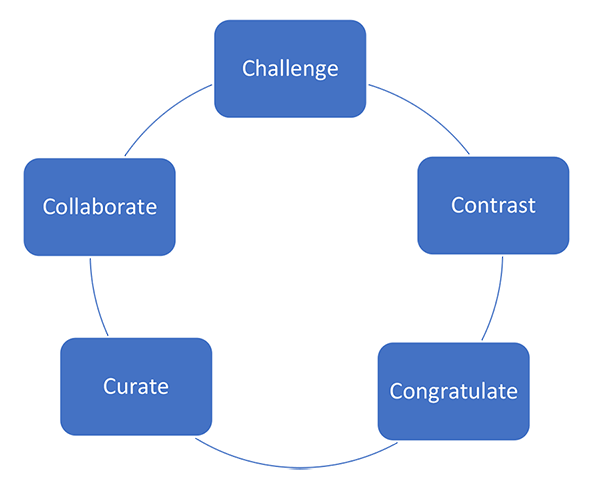
Is this you? There’s no money for big recruiting or retention bonuses. You can’t afford to lure high-priced talent away from competitors. Your training budget is limited. You’re not sure what automation or AI technology you can afford to invest in, much less how you can afford to train people to work with it.
When you’ve got to tackle skills gap problems with limited resources, the shortage of essential talent can be especially painful. This is a huge problem today, especially in middle market and small companies.
But there’s hope. In his book Stretch: Unlock the Power of Less, Scott Sonenshein argues that managers routinely underestimate their ability to get more out of the resources they have. Through an approach he calls “Stretching,” Sonenshein implicitly identifies tactics organizations can adapt to take advantage of latent capabilities in their existing talent resources.
Here are five insights adapted from Stretch that will help you develop tomorrow’s workforce more creatively when your resources are limited. They can be more easily remembered as the five C’s: Challenge, Contrast, Congratulate, Curate and Collaborate.
1. Challenge staffing assumptions. Are the skills needed stable or continually changing in the jobs you’re trying to fill? Are you making accurate assumptions about the level of training, experience and degrees needed to produce effective outcomes?
Malcolm Gladwell popularized the idea that it takes 10,000 hours of practice to become an expert in something. But Sonenshein points out that it’s hard to become an expert in an area that’s always changing. This means we need to rethink the amount of training necessary in jobs that are rapidly being transformed or reimagined.
For example, a major ship builder in the U.S. has stopped trying to hire experienced welders who are so scarce. Instead, they now focus on hiring entry level welders with just basic training who they can train further to meet their specific needs. In health care, delivering routine patient care with nurse practitioners and physician assistants has become a necessary alternative to seeking out more highly-trained, expensive physicians, who are in increasingly short supply.
Instead of pursuing more educated, hard-to-find candidates, ask challenging questions about the amount of training or degrees actually needed to perform rapidly evolving roles.
2. Create contrast within teams: Create a diverse team to develop more innovative solutions that will leverage limited talent resources.
There is a tendency to rely on human resources and talent “experts” to come up with solutions for critical skill shortages. But, historically, these groups have not been diverse in terms of gender, race or work experience.
The research is very clear, however, that teams with more diverse backgrounds (e.g. gender, race and functions) consistently outperform “dream teams” of experts, who are more likely to all be from HR. Non-experts won’t view resources in the ways that HR managers take for granted.
For example, Sephora is a multinational chain of personal care and beauty stores. But, in this company where women make up the majority of the engineering and digital staff, diverse technology teams don’t focus on the skills match of potential job applicants. Instead, they encourage candidates to apply for roles that may not explicitly fit their skills and experience, emphasizing their potential for growth.
This contrasts with the approaches of more traditional male-dominated tech firms who focus primarily on the skills match. More diverse teams at Sephora expand the field of potential new hires. This indirectly accelerates the development of new talent that is an important resource supporting future growth.
5 Practices for Maximizing Talent Resources

3. Congratulate yourself. Regularly practice gratitude for the talent/staff you have. (OK, this is a reach for a “c” word that’s relevant, but it will help you remember “gratitude”.)
Adapting this idea from Stretch, research shows that when people are grateful, they expand how they think about their existing talent resources. And, often, they will take actions that have both short and long term benefits for the organization.
Take time once a week to write down five things, big or small, about your staff or talent pool that you’re grateful for. For example, this gratitude exercise may make you more aware of:
- A veteran engineer who is proactively mentoring several younger staff.
- A new hire struggling to learn her job, but putting in extra time and effort to succeed.
- 3 strong candidates your recruiters have identified for an open machinist position.
This simple step reminds us to appreciate the employees and capabilities we do have. And Sonenshein says that being consciously grateful today also helps us make better decisions about the future.
Appreciating current talent assets can also encourage you to keep succession planning and employee development opportunities top of mind. Equally important, if you let your staff know you’re grateful, that goes a long way to building trust, which can improve employee retention.
4. Curate your successes: Make sure talent-related resources remain accessible and top of mind.
One of the by-products of the incredible pace of business and rapid employee turnover is the loss of valuable resources – programs, practices, know-how – that could immediately add value to your talent base.
When it comes to managing talent, it’s easy to forget what we have already done to be successful. Maybe it was a mentoring program that accelerated knowledge transfer, or a special source or approach to hiring new talent. “Forgetting” what we’ve learned about recruiting, developing and retaining staff with key capabilities limits our ability to extend resources we already have.
IDEO, the well-known design company, uses the metaphor of maintaining a museum collection to address knowledge retention challenges like this. They actually designate curators to catalog a diverse set of materials from previous projects – prototypes, sketches, (stories, frameworks) and memos. Could you create a better system to make sure you don’t “forget” effective programs and practices that define resources you already have for managing talent?
5. Choose collaboration over competition
When it comes to resources, Sonenshein divides the world into “chasers” and “stretchers.” Chasers are people and organizations who think the goal is always to acquire more resources. More money, people and equipment. As a result, they view every situation, including talent acquisition, as a competition. Stretchers, on the other hand, view resources as flexible and potentially abundant, so fighting over them actually reduces the chances of creating more. This makes collaboration much more appealing.
Of course, some talent resources can only be acquired through competition. After all, a young pediatric cardiologist will be enticed to locate in different cities. But the solution to many talent shortages lies in collaboration between organizations, as experienced by the growing number of companies participating in multi-employer workforce collaboratives. These groups give firms a way to cooperate to find solutions that will develop more talent resources.
To grow workforce resources look for opportunities to collaborate, instead of viewing the solution as winning a competition.
Critical skill shortages will be a fact of organizational life in the years ahead. Even in a recession, skills gaps will exist. The complexity of business today and rapidly advancing technologies make it impossible for the talent pool to keep up with the capabilities needed in fast growing companies. Thus, the answer to workforce challenges won’t be chasing more expensive talent, but rather finding creative ways to stretch assets you already have in hand.
